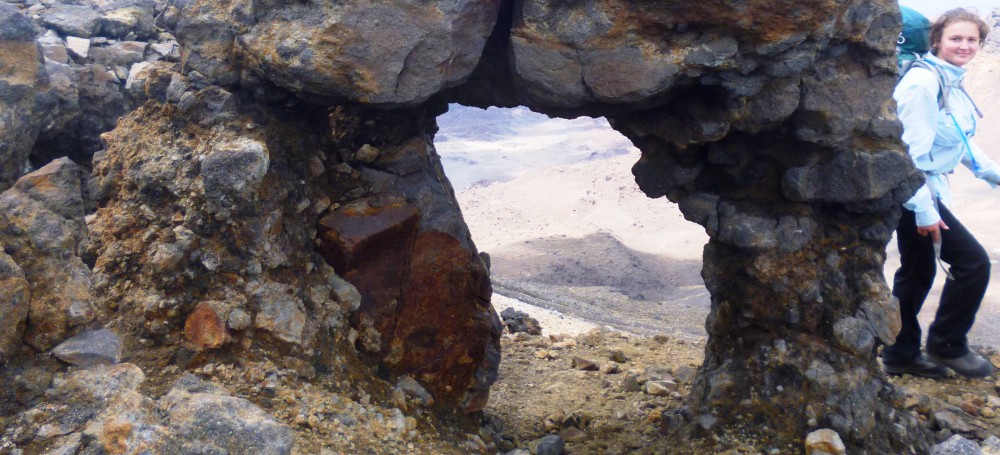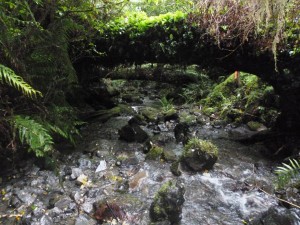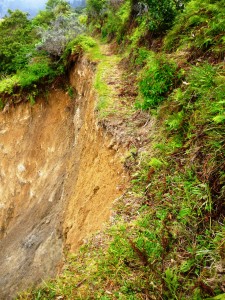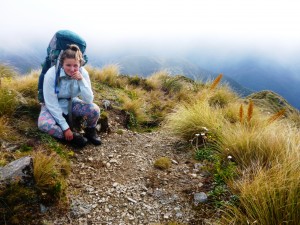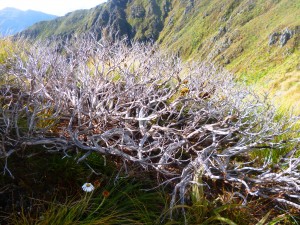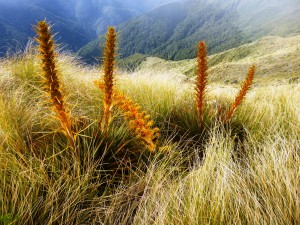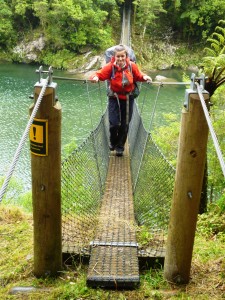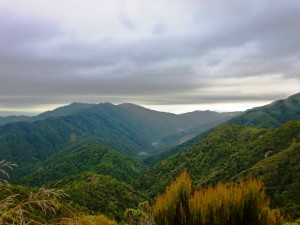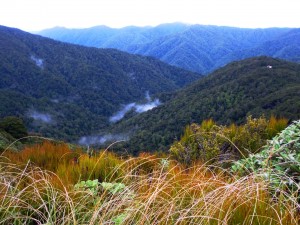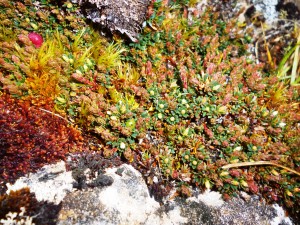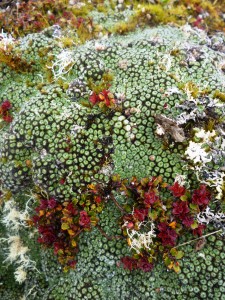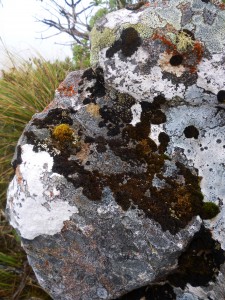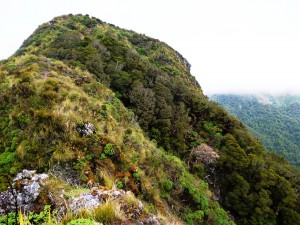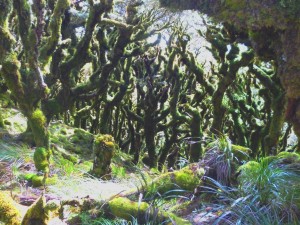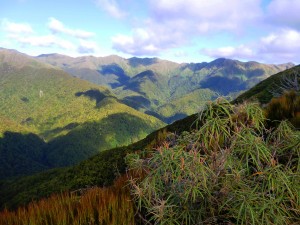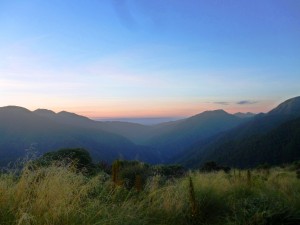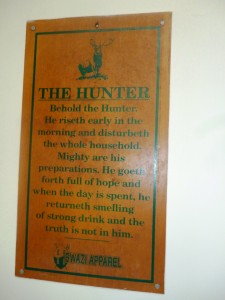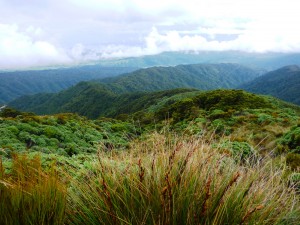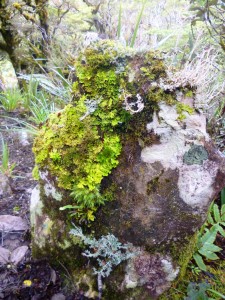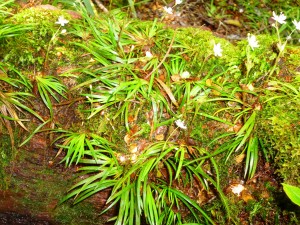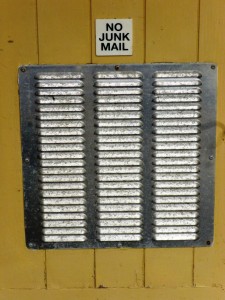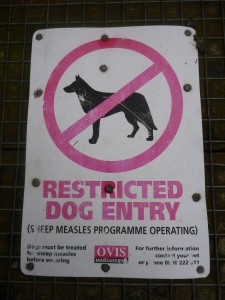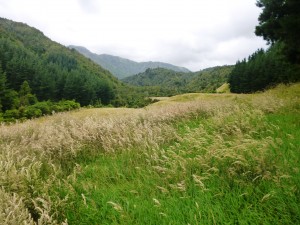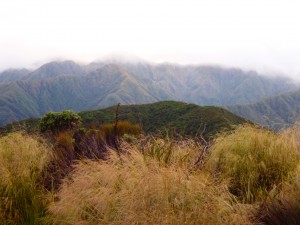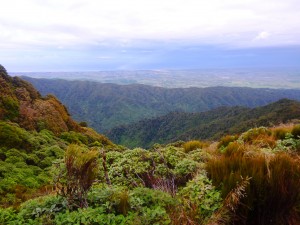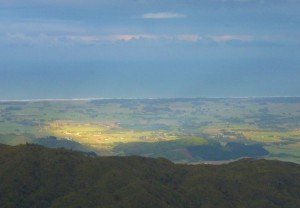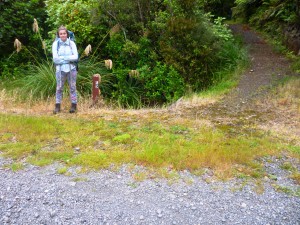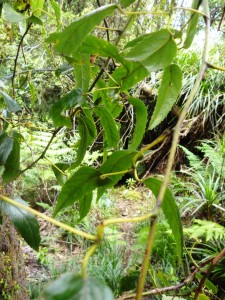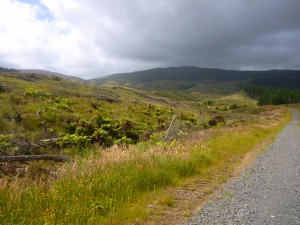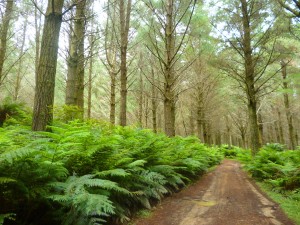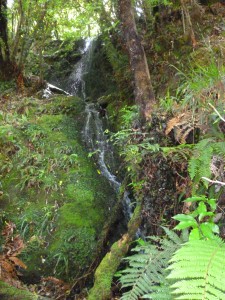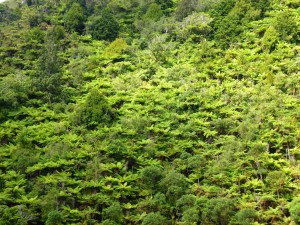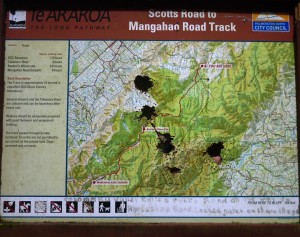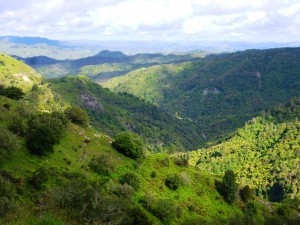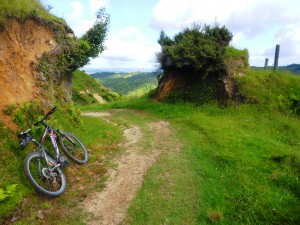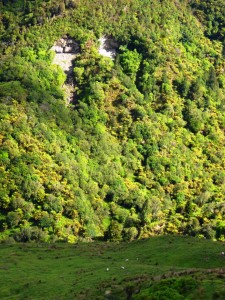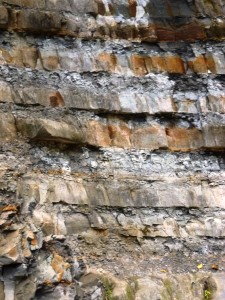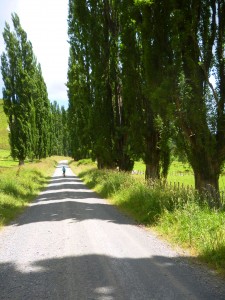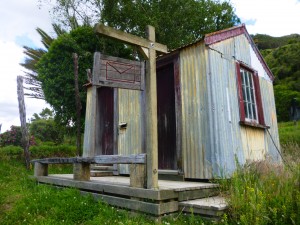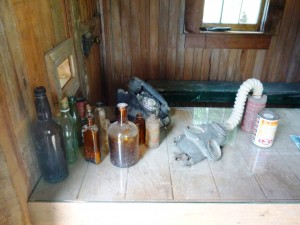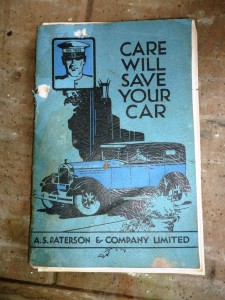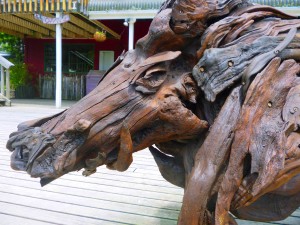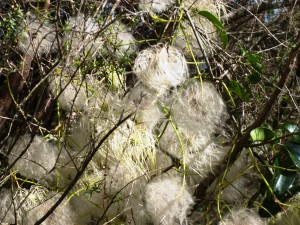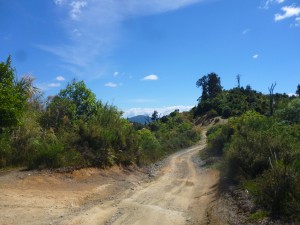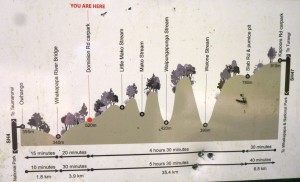Sunday, 12 January
Waitewaewae Hut to Otaki Forks (9.5 km)
We made an early start to cover the 10 km to Otaki Forks. I guess it would have been a pleasant walk on a hot day, but since much of the path was steep downhill, in rocky, flowing streams, slow progress and sodden feet were inevitable. God’s own tramping ground has two settings: “wet” and “wetter”, and today he had set it for it yet another rinse.
We heard one bird call, which sounded like a scratchy voice crying “Get it in!” One hawk sailed silently past, and otherwise … no wildlife for the whole day. The wet weather and dull light meant few photos.
Our conversation was mainly limited to nourishment fantasies. The massive weight of supplies with which we had waddled out of Palmerston North nine days ago was now down to two mug sachets of Watties’ soup and 37 squares of toilet paper. This was bad planning. We should have had more in reserve in case of being trapped by the weather.
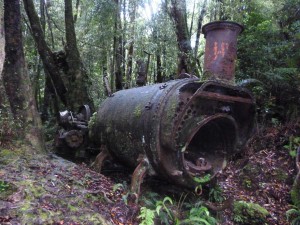 We found a logging relic, a steam engine sadly rusting at the edge of the long-disused tramway. Its old boiler gaped with a silent wail of abandonment. Now and again, we passed the remains of tram rails. “Look,” I said, “they’ve removed all the straight rail sections and left only the curved ones behind.” Hannah was outraged. “This is physical evidence of anti-gay propaganda!” she puffed.
We found a logging relic, a steam engine sadly rusting at the edge of the long-disused tramway. Its old boiler gaped with a silent wail of abandonment. Now and again, we passed the remains of tram rails. “Look,” I said, “they’ve removed all the straight rail sections and left only the curved ones behind.” Hannah was outraged. “This is physical evidence of anti-gay propaganda!” she puffed.
We saw one place, about two and-a-half hours south of the hut, which would have been suitable for camping, and a few others quite close to the forks. That was it for the length of the path from where we entered the bush from Poads Road on Wednesday. The huts are critical for the SOBO Tararua leg. We had thought that it did not matter much if we stopped when we got tired between huts; we were accustomed to making do with our tent. That approach works fine elsewhere on the trail – just not on this mountain range! The ground is seldom level, and where it isn’t tilted, it is either too stony, too squelchy, too exposed, or too thickly vegetated for setting up a tent. So, if you’re going to do this walk, organise your route so that you reach a hut each afternoon.
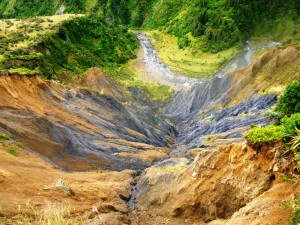 Hannah kept lagging behind. She took so long to catch up I thought she’d been raptured. If God had taken her with her brassy atheism, and left me with my shabby but still-under-warranty version of Christianity, I would have been Very Seriously Annoyed.
Hannah kept lagging behind. She took so long to catch up I thought she’d been raptured. If God had taken her with her brassy atheism, and left me with my shabby but still-under-warranty version of Christianity, I would have been Very Seriously Annoyed.
Two enormous landslips had to be negotiated. James, who must have passed this way the previous day, came to mind. With his fear of heights, he would have crapped himself, “Or at the very least, have done his raving nana,” said Hannah.
The first slip involved a steep detour; the second was fresh, and the path went narrowly and shatteringly close along its top lip. There was a mere 15 cm between our feet and the void that dropped away for hundreds of metres. The photograph does not do justice to the size and danger of the slip. Chests to the ground, breathing wet bracken and moving very slowly, we edged past. My nose was dripping. With no hands free and no dry tissues anyway, I had no choice: I wiped my snot on my sleeve. I hadn’t done that for four and-a-half decades, but luckily my technique was still good.
When we reached the swing bridge over the Otaki River, we knew the carpark was close and quickened our pace. Andrew had kindly volunteered to wait for us there at midday and give us a lift to Levin, where we could catch the bus home. It was a good moment when we saw him in the distance, standing next to his sparkly new car and waving. He is rather proud of his car. He had talked about it at the hut, in some detail.
There was a wee problem, though. For hours, I had been aware of an indescribable odour. We hadn’t left it behind us and I realised the stench wasn’t just stalking us – it was attached. It was my shoes. Could I climb into someone’s car with those horrors? No, but I did have a plastic bag in which to wrap them.
Then we thought about our clothes. Everything we had was wet and muddy. How could we sit on nice new upholstery? A furious, whispered emergency discussion was held over the last 100 metres to the car. Then I had an inspiration. We did each have one item of almost dry, mud-free apparel. “Do you think we could quickly change into our nighties?” I hissed. “No!” was Hannah’s emphatic, bug-eyed response. I couldn’t help laughing. I had a vision of the car being stopped by the police and what explanation the hapless Andrew could give for having two lightly clad, bruised and considerably rumpled females lolling in his vehicle. But it did not come to this. Our gracious chauffeur consented to transport us just as we were. Kiwi gallantry comes in many forms.
On the back seat, down the steep road to Levin, Hannah betrayed me by reading ahead in our Ben Elton book. “You’re cheating!” I gasped. “We normally read aloud to each other at night,” I explained to Andrew. “But I make her put her fingers in her ears and say ‘La-la-la-la-la-la’ during the rude parts. When she’s reading and a rude part comes up, I still make her put her fingers in her ears but she can’t do the la-las.” “Do you read Mills and Boons, then?” he asked.
In the main street of Levin, Hannah expressed her intention to remove her wet shirt and put on her fleece top. “I can’t see a loo anywhere, so I’ll just do it here,” she offered, scrabbling through her pack. “But everyone will see you in your bra!” I protested. “Oh mêh!” she shrugged.
Alas, there was no bus to Auckland until the next morning, so we bought our tickets and resigned ourselves to a night at the holiday park. First stop was for Nutella and peanut butter. I like Levin. I haven’t seen another town where there is a doggie hitching rail and water bowl outside the supermarket.
The library was advertising a sale: discarded books for a dollar each. I wanted to stock up for the day-long bus trip home. “You don’t have to schlepp along with me,” I said to Hannah, who groaned when I mentioned it. “You can sit here on the bench outside the supermarket and wait for me.” She was having none of it. “That would make me feel really anxious,” she protested, “because someone would ask me what I was doing and tell me to move on.” She was sweating. I had to clarify a point: “Just half an hour ago, you were going to take your shirt off in the street, and it didn’t bother you. So how is sitting here worse?” “It just is, OK?” A mother must compassionately negotiate many incomprehensions in her task of raising a child with an anxiety disorder. “Oh you are just a tangled pink fluffy mess of complexity and contradiction, aren’t you?” I grumbled.
At the library, the book sale didn’t offer much choice, but there was a large swelling of Mills and Boons and other bodice-rippers. Hannah spent a very happy hour hooting over the covers and reading the sordid synopses aloud. I put my fingers in my ears and went la-la-la but she only stopped when I backhanded her with my chosen hardcover about a priest who had lost his faith.
In romance titles, “wild” is ubiquitous: Wild fury, Wild hearts, Wild concerto, Wildfire, and then there was Defy the eagle, Pirate’s promise, and my favourite: Ecstasy’s chains. “Those are brilliant,” I said, but don’t you think we could invent something better? What about Treacly toilet, or Tempestuous testicles?”
“I want this one,” finally announced my Goth and Death Metal child, trying to hand me Deceive not my heart. The cover colours rivalled a packet of liquorice allsorts, and the slightly embossed, entwined and gilded figures promised vulgar biological enlightenment. “Well, no problem, here’s a dollar, go buy it then,” I said, holding out a coin. “Shoot Mom! I can’t be seen buying that! You’re going to get it for me, aren’t you?” Greater love, and all that…
Sally found us at the holiday park and retrieved her locator beacon. She said there were winds of 100 kph up on the range now. We were very relieved not to be still out there. On the exposed ridges, the large surface area of a backpack would act like a sail.
Lying in a motel bed after having a hot shower and a takeaway roast, and knowing the next day would involve no walking felt like the deepest possible satisfaction. It was climax’s cradle, bosom’s balm, passion’s protruding promise… whatever. However, sleep was a while away because Hannah didn’t want to read the incisive and thought-provoking Ben Elton any more. No. It was Deceive not my heart for us tonight.
Suffice to say the heroine spent a lot of time being unconscious. Somehow, passion bludgeoned a substantial amount of her cortical functioning. But lo! The hero rode a horse called “Tempete” which, luckily, could think for all three of them.
Hannah droned through the turgid text, occasionally stopping to make ringside comments which left me weeping and weak: “Ooo – she’s about to eat the forbidden banana, isn’t she?” Comments like this are the reason why I don’t completely disown her.
